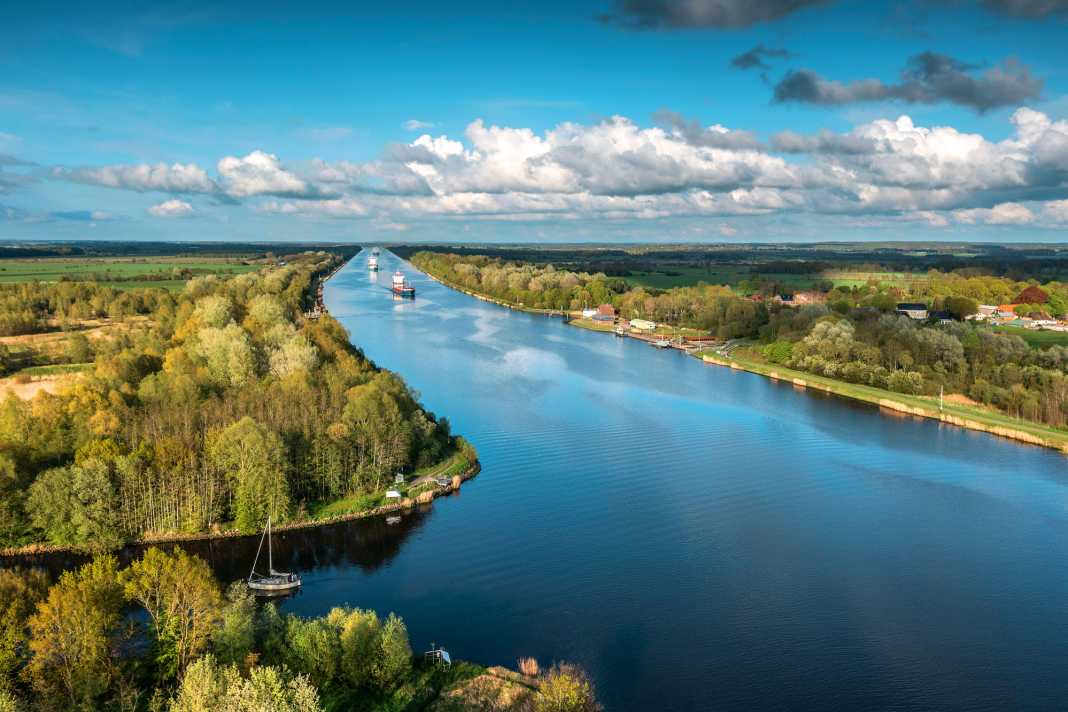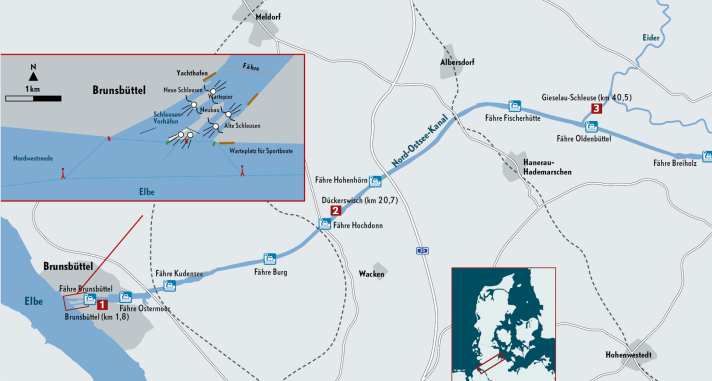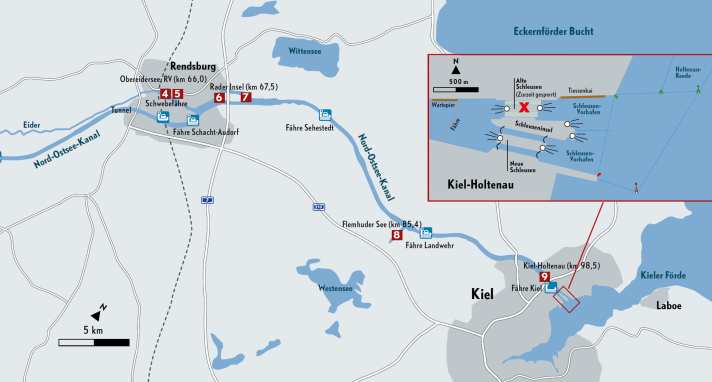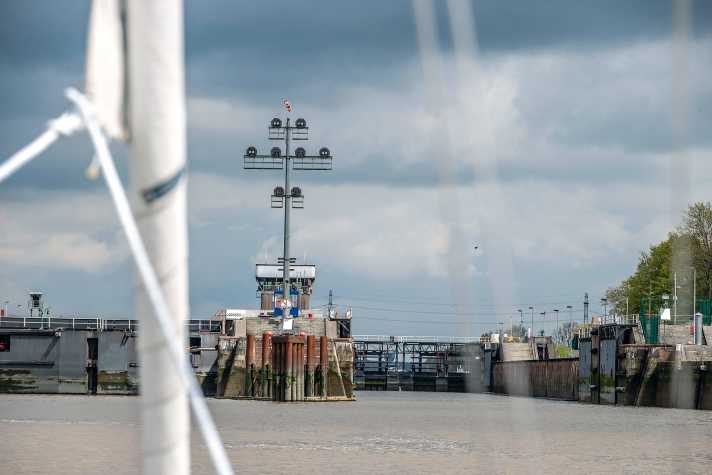





- What to look out for when entering the Kiel Canal
- Rumours and myths about the NOK persist
- This is what you need to bear in mind as a sailor in contact with the big pots
- These places are ideal for a stopover on the Kiel Canal
- Signs and signals in the Kiel Canal
- 13 important practical tips for the Kiel Canal
- Facts and figures: the NOK in figures
If you ask Hamburg sailors how often they have travelled through the Kiel Canal (NOK) with their boats, you often get a shrug of the shoulders. Many have travelled to the Baltic Sea and back so often over the years that they have lost track. Some, on the other hand, have numbers at the ready as if shot from a pistol. And they are quite impressive: "29, 43, over 50 times!" These are mostly owners with moorings on the Elbe or North Sea who are drawn to the Baltic Sea in the summer for a holiday cruise. But some of them are also regatta sailors who take part in the Skagen Round, for example: first around Denmark, then back through the canal. Others make the annual pilgrimage from the Baltic Sea to Heligoland for the North Sea Week.
There are also two factions among the canal boat riders: Some motor along at the maximum permitted speed of 15 km/h within eight to ten hours. The others make one or even several stopovers. "We use the canal as part of our holiday and don't stress about it," says the owner of a Dehler 36 during small talk from boat to boat before the gate opens again and he chugs off. In view of the water sports boom in Germany in recent years, more newcomers than ever will be sailing through the canal for the first time in 2024. For them, the more pressing question of how to get in and through safely in the first place naturally comes before the question of possible stopping points en route. And how narrow it really is when encountering the big boats that many people fear. In short, what you should generally look out for when travelling along the canal.
One person who should know is Andreas Jessen from the Northern Waterways and Shipping Authority, who has been working on site for over 20 years and was a lock keeper himself. We meet him in Holtenau, the eye of the canal's needle. Only the two large lock chambers have been working there since 2015; the smaller ones need to be replaced. In the meantime, they have even been filled with sand and grass is growing on top. The ground investigations are currently underway and will probably not be completed before 2025. The specific completion date is difficult to estimate. "There are actually hardly any accidents involving sailors," says Jessen reassuringly, "the most likely scenario is someone slipping on the friction blocks in the lock chambers when stepping onto the jetty and injuring themselves."
What to look out for when entering the Kiel Canal

Friction woods because they are actually used to keep the big boats away from the lock wall. Their function as floating docks and mooring facilities for yachts is secondary. "It's more the little snags in the lock procedures that sometimes make life difficult for us," continues Jessen. The classic case: crews have not familiarised themselves with the light signals and registration procedures. "Some simply sail in front of the lock chambers and circle around waiting for an opening. Or they then radio the lock first. Of course, they interfere with the entry or exit of the commercial vessels."
The consequence is usually a - sometimes ill-tempered - reprimand from the keeper via loudspeaker or radio. Skippers also like to think that green lights on the signal masts are a request to enter. But this is wrong; only when only white, intermittent lights are illuminated are pleasure craft allowed into the chambers. The right thing to do is to moor or circle in the waiting areas and, ideally, first check by radio whether a lock for pleasure craft is already scheduled.
"This is usually the case when other yachts are already waiting," says Andreas Jessen. If every crew then enquires again, the lock keeper has to repeat himself unnecessarily often; however, he needs the call time more for the commercial vessels. "Twice as many of them lock as pleasure craft, yet coordinating the leisure skippers takes much more time." Many simply forget to tell us what they want when they call: in or out of the canal.
Rumours and myths about the NOK persist
The decommissioning of the small chambers in Kiel means that yachts here often have to lock together with commercial vessels. The situation is different in Brunsbüttel, where there are still the two small locks, where yacht crews can sometimes keep to themselves. They are located on the upstream side of the canal.

The NOK is particularly busy in summer, when many German Elbe and North Sea sailors and crews from the Netherlands move to the Baltic Sea. In the early and late season, however, when owners move their boats from winter storage to summer berths or vice versa at the start of the season, things are more relaxed than you might expect. Newcomers to the canal are particularly afraid of the propeller water of the big boats. Rumours of yachts being tossed around like playthings persist.
Yachts have even been pushed under water. "I've never come across that in 25 years," counters Andreas Jessen. "What is true is that many, if not all, commercial vessels can switch off their propellers in the locks." At the very least, the wardens ask every ship to minimise its speed, if only to protect the systems: The water jet from the propellers washes out the joints in the lock basin and puts unnecessary strain on the gates.
This is what you need to bear in mind as a sailor in contact with the big pots
"Our people always let the commercial shipping in first, then they allocate places to the pleasure craft. When leaving, however, the yachts have priority," explains Jessen. "If you keep your distance from the big boats and avoid the area directly behind them whenever possible, you'll hardly have any problems." Once moored, little spectacular happens. The lift of the lock in Kiel is usually so small that the sailors hardly notice the difference in water level. In Brunsbüttel, on the other hand, it can be a few metres up or down, depending on the tide and water level of the Elbe.
So dramas are rare, but bizarre situations are. For example, crews communicate their position in latitude and longitude or even their MMSI extensively when logging on. With lock radio, however, less is more. The call sign of the lock, the name of the ship and the direction it is travelling in - that's enough. The keeper can see the boats very well from his high position anyway.
Once you are finally on the canal, there are more opportunities for stops than many people think. If you lock into Brunsbüttel, you can go directly behind it into the small harbour. It is popular because it has a few electricity connections and there are restaurants and cafés right in front of the jetties. It's only a short walk into the town, a somewhat sleepy nest. Only the harbour's publicly accessible sanitary facilities are more notorious than famous.
These places are ideal for a stopover on the Kiel Canal
In the season, Brunsbüttel harbour is often so full by the afternoon that the yachts are packed together. Tourists stroll ashore and curiously eye the yachties. They quickly strike up conversations with each other and share their sometimes exciting stories. If you want to know everything about the construction, the history of the canal, the technology of the locks and ferries, visit the canal museum (www.schleuseninfo.de).
However, the harbour is a little restless at night, as the nearby lock is in operation 24 hours a day. You can clearly hear the roar of the engines of the big ships. Construction work is also currently underway on the 5th lock chamber. As soon as it is finished, probably towards the end of 2026, the two large chambers will be closed for an urgently needed renovation. At the moment, it looks like the work will take another five years or so. Operating a large construction site in the centre of the facility while the locks are still in operation on both sides is probably more difficult than expected.
But at least the federal government has now tackled the long-neglected maintenance and modernisation work. This is a good thing, as the canal also helps to reduce CO2 emissions. After all, the alternative to the canal passage is the long diversions around Skagen.
Idyllic or with a view of the cargo ships?
If you want to marvel at the big ships up close with a sundowner in the cockpit, you can moor at the bow and stern piles at the Dückerswisch siding at kilometre 20.7 of the canal. They are located in a small bulge behind a headland. Although there is swell, the view of the traffic is truly spectacular.
One of the canal's most popular spots is more hidden and idyllic: in front of the Gieselau lock at the junction to the waterway of the same name (km 40.5), which leads further into the Eider. Its almost central location in the Kiel Canal makes it an ideal place to stop. You turn half a mile inland and are picturesquely situated in front of the pretty lock with its lifting bridge, surrounded by trees and fields, all alongside jetties in a seemingly paradisiacal tranquillity. Crews chat, barbecues are fired up and in summer the 20 or 30 seats are sometimes all taken.
There's not much traffic at the moment," says the lock master, who has little to do in the middle of May. "Yesterday I had four locks in one day," he reports. The route into the Eider is not very busy. However, the scenic beauty paired with solitude also has its appeal, even for celebrities, as he explains when asked about the highlights of his job as a lock keeper. "Markus Lanz and Thomas Gottschalk once passed through here. Lanz had raved to the TV veteran about the tranquillity and idyll of the Eider. They even took a souvenir photo with my colleague."
There are many mooring options in the NOK
In fact, the square is very peaceful. Only here and there is a bit of unrest: When a really big pot passes, it causes the water level in the canal to rise suddenly by around 50 or 60 centimetres and then drop again shortly afterwards. The boat then jerks into the lines. Only in strong northerly winds is the club harbour a little choppy.
If so, the Büdelsdorf Yacht Club harbour on the other bank to the north-east is an alternative. The small facility with its extremely friendly harbour master is highly recommended. Various supermarkets for supplies are hidden behind a small wood, and you can sit opposite with a view of the church tower of Rendsburg and the masts of the marina.
Or you can opt for one of two mooring options at Borgstedter See, which has two entrances - one just before and one behind the motorway overpass, from which so many yachties have already seen the canal from above when speeding across. The jetties of Yachtservice Schreiber are located on Lake Borgstedt, a small but well-equipped facility which, although only a few hundred metres from the Kiel Canal, is sheltered.
Further east, at kilometre 70, it is also worth turning off deeper into the lake and using the Borgstedt yacht club facilities. Depending on the wind, however, you can clearly hear the nearby motorway. If the crew chugs further north-east through the canal, the only idyllic anchorage on the NOK is at kilometre 85.4, i.e. just an hour or so before the end - or shortly after entering the canal, depending on the direction of travel: Flemhuder See.
The Kiel Canal is also practical, fascinating and instructive for sailors
The water initially looks bigger than it is: It is only about two or three hundred metres deep before anchoring between the laid out reed buoys or mooring to the completely oversized and very closely spaced piles with a line to the bow and stern piles. The boundary of the anchoring area is not too bad, as it quickly becomes shallow behind it anyway. Despite its proximity to the canal and the convoy of freighters there, the Flemhuder See is a really tranquil place. There is hardly any swell, so nothing stands in the way of a quiet evening, perhaps with a chat with the neighbouring berth holder in the dolphin packet. Of course, there is no catering.
You have now almost reached the end of the canal. Before the lock in Holtenau, there is only the waiting jetty for yachts on the inside, where crews can also spend the night. What remains at the end of a canal crossing is the realisation that if you divide up your route and vary the overnight stops, you will get to know different facets of this monumental structure. With each passage, the canal becomes more familiar and loses its initial terror, especially when it comes to its proximity to commercial shipping.
You also learn to come to terms with the unpredictable weather: The wind is usually weaker than on the coast and blows mainly in the direction of the canal. If you catch it from astern, the passage does not have to be sail-free, even if the engine always has to be running and the cone set. The 250 nautical mile shortcut in contrast to the route around Skagen has its price. But every crew is happy to pay it.
Signs and signals in the Kiel Canal

An intermittent white light in front of the lock allows yachts to enter. All other combinations with red or green are intended for commercial shipping.
Three flashing red lights in the siding mark a no-entry zone, even for pleasure craft, because very large vessels are approaching.
The canal must be travelled on the right. Signs sometimes stipulate minimum distances from the bank in metres.
13 important practical tips for the Kiel Canal
NOK tip #1
If you are approaching the locks in Brunsbüttel or Kiel-Holtenau, it is best to listen in early on the radio (Brunsbüttel: VHF channel 13, call: "Kiel Kanal I"; Holtenau: VHF channel 12, call: "Kiel Kanal IV"). If there are already other pleasure craft in the waiting area, listen in, otherwise call the lock and ask when you can expect to be locked. Important: Indicate in which direction you want to lock, i.e. in or out! The lock keepers usually answer immediately. Pleasure craft without radio equipment can also call (Kiel: 0431/360 31 52, Brunsbüttel: 04852/88 52 52).
NOK tip #2
Do not circle too close to the lock when waiting. Outside, there is a waiting area in Holtenau to the north of Tiessenkai, in Brunsbüttel it is located up the Elbe directly next to the canal. In Kiel there is a waiting area on the north bank inside the canal with a digital display of the call numbers, in Brunsbüttel there is the harbour and a waiting area on the south bank by the small lock.
NOK tip #3
The entrance to a chamber is only free when the white lights of the large indicator directly in the centre of the lock are flashing. In Holtenau, yachts often have to lock together with commercial vessels, while in Brunsbüttel only pleasure craft can be locked in some cases due to the smaller locks that are still intact there. All other signalling combinations, including those with a green light, are for commercial vessels! The lock keepers also announce the authorised entry via radio and loudspeaker and usually tell you on which side of the lock and whether you should moor in front of or behind the commercial vessels.
NOK tip #4
Enter the lock quickly. Move as far forward as indicated or possible. Hang the fenders so low that they are half on the waterline. Moor with fore and aft lines. A stern spring is recommended so that the yacht lies more quietly even in screw water. To do this, a crew member must jump onto the low floating dock (rubbing strakes), ideally at the shroud on large boats. Be careful, the flooring is sometimes slippery!
NOK tip #5
Pass the commercial vessels quickly, especially if their propellers are still running. However, many ships can switch off their engines. Only pass behind ships if the lock keeper instructs you to do so.
NOK tip #6
Only use the colour-coded areas in the lock where the floating docks are covered with rubber mats or metal grating. Make fast to the rings. Do not climb up the ladders!
NOK tip #7
There is a charge for the passage; you can pay in Holtenau at the machines in front of the lock (Tiessenkai) or in the waiting area in front of the lock on the north bank of the canal. On the Gieselau Canal, pay at the lock keeper's office, in Brunsbüttel at the inspector's office in the waiting harbour.
NOK tip #8
In Brunsbüttel, a display in the lock shows the current strength and direction of the Elbe.
NOK tip #9
Under www.wsa-nordostsee-kanal.wsv.de you can find good information and the information sheet for pleasure craft as a PDF. It also lists the permitted daily sailing times.
NOK tip #10
Keep to the right in the canal, especially when very large commercial vessels are approaching. It only becomes shallow relatively close to the bank. Exception: when signs prescribe a greater distance.
NOK tip #11
Sailing is only permitted with the engine running and the cone set.
NOK tip #12
There are eight designated moorings for overnight stays (see map).
NOK tip #13
If all the lights at the points are red, yachts are also not allowed to proceed! Listen to the radio.
Facts and figures: the NOK in figures
- Every year, around 29,000 commercial vessels and 12,000 pleasure craft the channel
- Its construction time was only 9 years (1886 to 1895)
- Travelling through the canal saves ships a 250 nautical miles long diversions around Skagen
- The channel is 53.3 nautical miles or 98.637 km long. A sign shows the distance every 500 metres (ascending from west to east)
- 10 Bridges and 14 Ferries cross the canal
- 12 points serve as waiting zones so that very large ships do not have to pass each other too closely
- The construction of the 5th lock in Brunsbüttel will cost 830 million euros
- Shipping companies pay up to 10,000 euros. In return, they save costs for up to 20 tonnes Fuel in
- From 3.10 metres Draught or 20 metres length, yachts need a pilot and an active AIS

